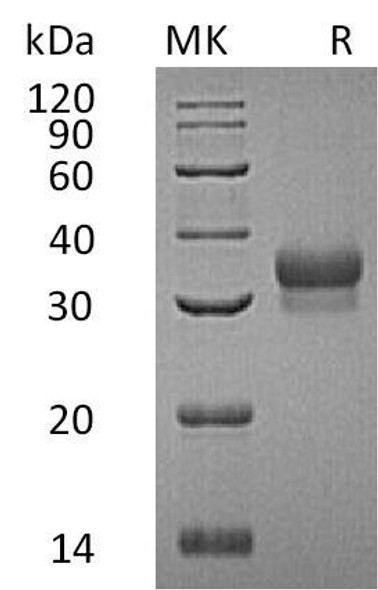Description
| Product Name: | Human EFNB1 Recombinant Protein |
| Product Code: | RPPB5882 |
| Size: | 20µg |
| Species: | Human |
| Target: | EFNB1 |
| Synonyms: | ephrin-B1, LERK2, EPLG2, Elk-L, EPH-related receptor tyrosine kinase ligand 2, EFL-3, ELK ligand, CFND, CFNS, Craniofrontonasal Syndrome (craniofrontonasal dysplasia), MGC8782. |
| Source: | Escherichia Coli |
| Physical Appearance: | Sterile Filtered colorless solution. |
| Formulation: | The EFNB1 solution (1mg/ml) contains 20mM Tris-HCl buffer (pH 8.0), 0.4M Urea and 5% glycerol. |
| Stability: | Store at 4°C if entire vial will be used within 2-4 weeks. Store, frozen at -20°C for longer periods of time. For long term storage it is recommended to add a carrier protein (0.1% HSA or BSA).Avoid multiple freeze-thaw cycles. |
| Purity: | Greater than 95% as determined by SDS-PAGE. |
| Amino Acid Sequence: | MGSSHHHHHH SSGLVPRGSH MLAKNLEPVS WSSLNPKFLS GKGLVIYPKI GDKLDIICPR AEAGRPYEYY KLYLVRPEQA AACSTVLDPN VLVTCNRPEQ EIRFTIKFQE FSPNYMGLEF KKHHDYYITS TSNGSLEGLE NREGGVCRTR TMKIIMKVGQ DPNAVTPEQL TTSRPSKEAD NTVKMATQAP GSRGSLGDSD GKHETVNQEE KSGPGASGGS SGDPDGFFNS K |
EFNB1 is a member of the Eph family. The cell-surface proteins Ephrins split into two groups, ephrin-A and ephrin-B, based on their structure and function and perform as ligands for Eph receptors. The transmembrane EFNB1 proteins have conserved cytoplasmic tyrosine residues that are phosphorylated upon interaction with an EphB receptor. In addition, EFNB1 transduces outside-in signals by C-terminal protein interfaces which influence integrin-mediated cell attachment and migration.
EFNB1 Human Recombinant produced in E.coli is a single, non-glycosylated polypeptide chain containing 231 amino acids (28-237) and having a molecular mass of 25.3 kDa.The EFNB1 is fused to a 21 amino acid His-Tag at N-terminus and purified by proprietary chromatographic techniques.
| UniProt Protein Function: | EFNB1: a type I membrane protein of the ephrin family. A ligand of Eph-related receptor tyrosine kinases EphB1 and EphA1. Ephrins and ephrin receptors mediate numerous developmental processes, particularly in the nervous system. Ephrin-B1 may play a role in cell adhesion and functions in the development or maintenance of the nervous system. Binding to its receptor induces the collapse of commissural axons/growth cones in vitro. Induced by TNF-alpha. Expressed in brain, heart, placenta, lung, liver, skeletal muscle, kidney, and pancreas. |
| UniProt Protein Details: | Protein type:Membrane protein, integral; Ligand, receptor tyrosine kinase Chromosomal Location of Human Ortholog: Xq12 Cellular Component: integral to plasma membrane; cytoplasm; plasma membrane; synapse; nucleus; lipid raft Molecular Function:protein binding; ephrin receptor binding Biological Process: axon guidance; cell-cell signaling; ephrin receptor signaling pathway; positive regulation of T cell proliferation; cell adhesion; embryonic pattern specification; neural crest cell migration Disease: Craniofrontonasal Syndrome |
| NCBI Summary: | The protein encoded by this gene is a type I membrane protein and a ligand of Eph-related receptor tyrosine kinases. It may play a role in cell adhesion and function in the development or maintenance of the nervous system. [provided by RefSeq, Jul 2008] |
| UniProt Code: | P98172 |
| NCBI GenInfo Identifier: | 1706668 |
| NCBI Gene ID: | 1947 |
| NCBI Accession: | P98172.1 |
| UniProt Secondary Accession: | P98172,D3DVU0, |
| UniProt Related Accession: | P98172 |
| Molecular Weight: | 346 |
| NCBI Full Name: | Ephrin-B1 |
| NCBI Synonym Full Names: | ephrin-B1 |
| NCBI Official Symbol: | EFNB1�� |
| NCBI Official Synonym Symbols: | CFND; CFNS; EFB1; EFL3; EPLG2; Elk-L; LERK2�� |
| NCBI Protein Information: | ephrin-B1; EFL-3; LERK-2; ELK ligand; ligand of eph-related kinase 2; eph-related receptor tyrosine kinase ligand 2 |
| UniProt Protein Name: | Ephrin-B1 |
| UniProt Synonym Protein Names: | EFL-3; ELK ligand; ELK-L; EPH-related receptor tyrosine kinase ligand 2; LERK-2 |
| Protein Family: | Ephrin |
| UniProt Gene Name: | EFNB1�� |
| UniProt Entry Name: | EFNB1_HUMAN |






